As we embark on the season of turkey consumption, it’s a fun time to highlight what it is that wild turkeys are out there eating this time of year. Spoiler alert: it isn’t stuffing, casseroles, or morsels of their brethren. Rather, a wild turkey feast involves the fruits and seeds that native plants cook up. By no means is the following list exhaustive, but here’s some of what’s on the menu for our odd but beloved feathered friends.
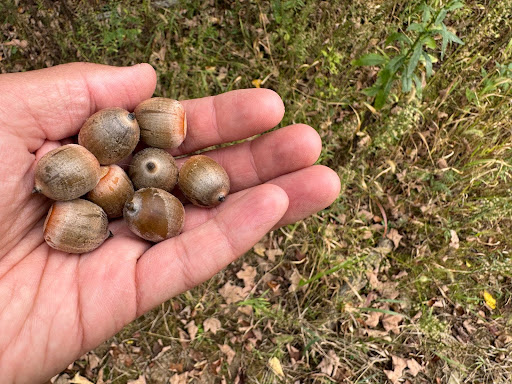
ACORNS
Lately it’s been hard to write conservation articles and not mention oak trees. Their offerings to wildlife are numerous, including the calorie-dense and readily accessible acorns they produce come fall. Wild turkeys, in addition to a variety of other wildlife, seek out acorns to bolster their fat reserves before the onset of winter. If you have oak trees on your land, it is worthwhile to protect them. If you don’t, consider planting a few. Most oaks take a long time to mature and won’t produce acorns for several decades, but future generations of turkeys stand to benefit!
There are plenty of oak species to pick from, though what’s considered native will vary depending on what state you’re in. Here in Pennsylvania, common oaks include:
- White Oak (Quercus alba)
- Swamp White Oak (Quercus bicolor)
- Chestnut Oak (Quercus montana)
- Red Oak (Quercus rubra)
- Black Oak (Quercus velutina)
- Pin Oak (Quercus palustris)
- Scarlet Oak (Quercus coccinea)

HICKORIES
In the same vein, hickory nuts offer wild turkeys a vital boost of nutrition before winter conditions set in. You’re likely to find the divided outer husks of their fruit scattered throughout the forest floor. Of course, it’s what’s within the husks that the turkeys really want. There are several hickory species native to Pennsylvania, and they occupy a variety of different environments. Some common hickories include:
- Shagbark Hickory (Carya ovata)
- Shellbark Hickory (Carya laciniosa)
- Bitternut Hickory (Carya cordiformis)
- Mockernut Hickory (Carya tomentosa)
- Pignut Hickory (Carya glabra)
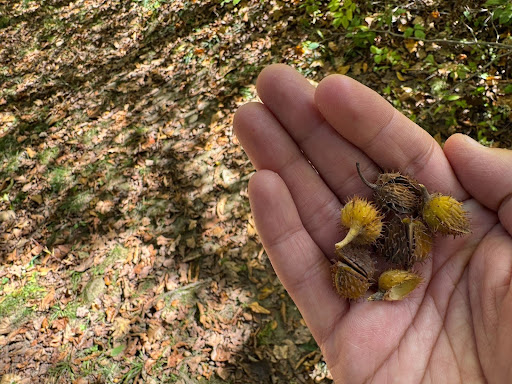
BEECH NUTS
The American Beech (Fagus grandifolia) produces nutritionally valuable fruit known as beech nuts. Similar to both hickories and oaks, beech nuts are packed with calories that go a long way in sustaining wild turkeys into the early parts of winter.
Unfortunately, American Beech is a species with a new and greatly concerning disease: Beech Leaf Disease. The disease is spread by a nematode, and is currently causing mass die offs of this iconic tree species. While we’ll continue to hold out hope, American Beech may meet a fate similar to its distant relative, the American Chestnut (Castanea dentata). But for now, wild turkeys can still seek out and enjoy the fruits of American Beech.
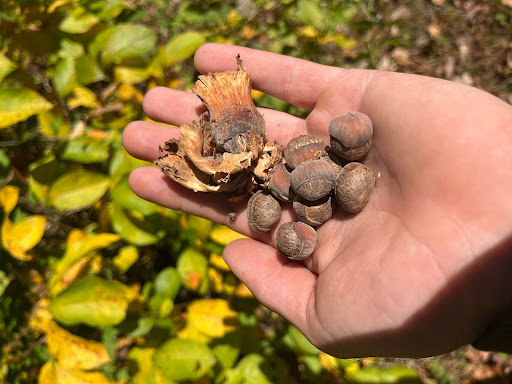
HAZELNUTS
American Hazelnuts have some of the most sought after fruit in the forest – so much so that it’s a challenge to harvest any before they’re plucked and devoured by squirrels and other wildlife. While these aren’t the source of the delicious hazelnut flavor you’ll find in local coffee shops (see European Hazelnuts), they probably have equivalent appeal to turkeys. This is a food item they target in early fall to store up fat, similar to acorns, hickories, and beech nuts.
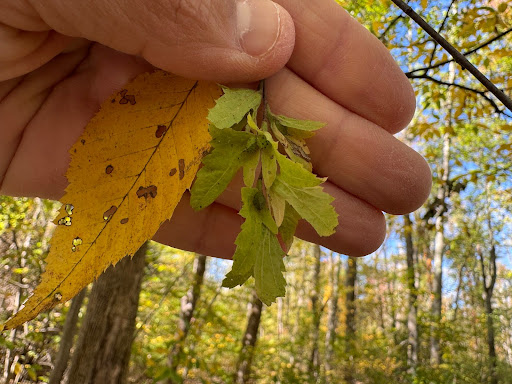
MUSCLEWOOD & HOPHORNBEAM SEEDS
Musclewood (Carpinus caroliniana, pictured above) and Hophornbeam (Ostrya virginiana, pictured below) both belong to the Betulaceae family, better known as the birches. Like other members of that family, both species produce flowers that, once pollinated, turn into tiny nutlets. While they are smaller and possess fewer calories than an acorn, hickory, beech nut, or hazelnut, the seeds produced by these trees are nutritious and are readily consumed by wild turkeys and other game birds.
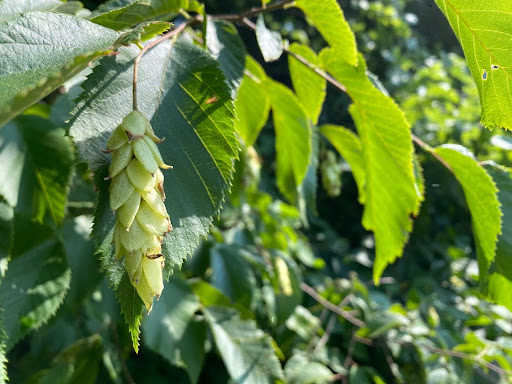
Musclewood and hophornbeam nutlets typically remain on the trees into winter, offering turkeys something to eat if we get a snowstorm that buries any of the other food items they favor. Their fruit may not be mighty, but they do their part in supporting wild turkey populations.
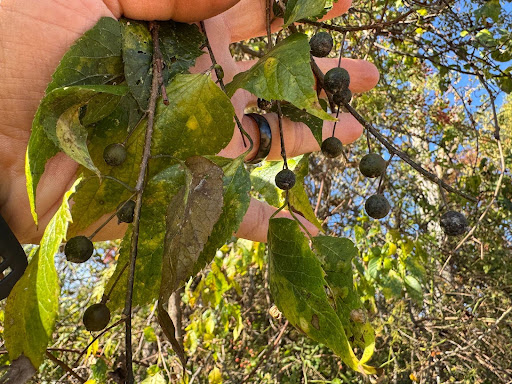
HACKBERRIES
When the forest floor is covered with snow, turkeys have to work a little harder to forage. That is unless a patch of Common Hackberries (Celtis occidentalis) is nearby. The tiny, dark fruit of this species often remains on the tree, providing turkeys a nutritious snack suspended above the frozen understory below. Many songbirds seek out these fruits though, so their availability to wild turkeys may be dictated by a little avian competition. This is an underappreciated species, but not by turkeys.
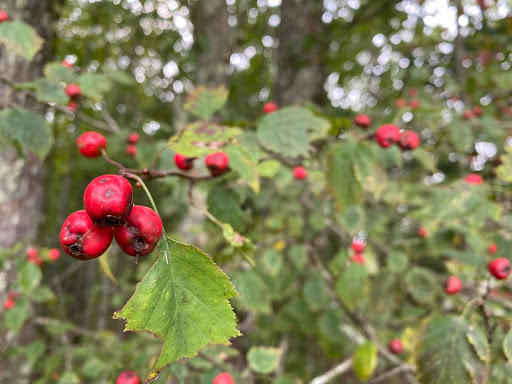
HAWTHORNS
Although they may be unwelcoming to people due to their intimidating thorns, Hawthorns (Crataegus species) are readily consumed by wild turkeys and other wildlife. There are several native species, They’re among the most challenging types of shrubs to identify to species, providing headaches to naturalists far and wide.
What they provide turkeys, conversely, is a bounty of delicious red berries. If you happen to be interested in fortifying your property with thorny thickets, consider adding some native hawthorns. One thing they’ll have trouble keeping out though, are hungry turkeys. Some native hawthorns include:
- Dotted Hawthorn (Crataegus punctata)
- Fireberry Hawthorn (Crataegus chrysocarpa)
- Cockspur Hawthorn (Crataegus crus-galli)
- Washington Hawthorn (Crataegus phaenopyrum)
- Bigfruit Hawthorn (Crataegus macrosperma)

PARTRIDGE PEAS
The only non-tree or shrub to make the list, but one that absolutely needs to be mentioned, is the Partridge Pea (Chamaecrista fasciculata). Better known for their beautiful yellow flowers, the seeds that follow their blooms are a delicacy in the turkey world.
You’ll typically find partridge pea growing out in wild meadows alongside some of our other well known forbs, such as mountain mints, black eyed susans, milkweeds, and bergamots. They’re a relatively short species, growing just a foot or three tall (which is about eye level for wild turkeys). If you’re looking for an attractive flowering plant that stands to benefit turkey populations, consider planting the humble but incredibly beneficial partridge pea.
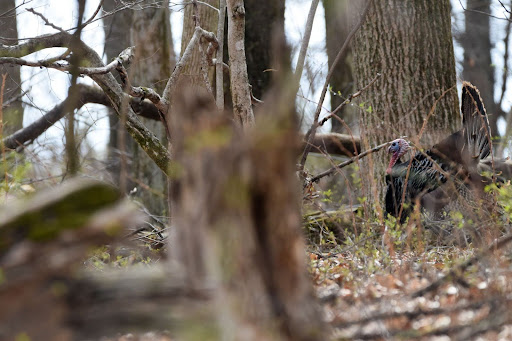
MORE FOOD FOR WILD TURKEYS
Again, it’s worth mentioning that what we’ve listed is a mere fraction of what wild turkeys like to eat come Thanksgiving. They’re opportunistic omnivores and will make due with quite a bit. Some honorable mentions include:
- Persimmon (Diospyros virginiana)
- Witch Hazel (Hamamelis virginiana)
- Crabapple (native Malus species)
- Black Cherry (Prunus serotina)
- Wild Grapes (native Vitis species)
The wonderful thing about all of the species we mentioned is they support far more than just wild turkeys. If you spend time around any of the native plants we’ve highlighted, you’re likely to encounter a suite of other wildlife. That could include red squirrels, blue jays, black bears, and plenty more. Furthermore, the insects that native plants support are both incredible and food for turkeys too.
Unsurprisingly, the best way to give thanks to wild turkeys is to add the plants that have ensured their survival over evolutionary time. There is no shortage of native plants to pick from, but on behalf of wild turkeys, we hope you choose to pick a few.
As always, thanks for reading.
-Sebastian Harris, Conservation Biologist
